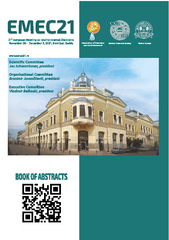Приказ основних података о документу
Elemental Profile of Hashimoto’s Thyroiditis: Thyroid Tissue, Blood, and Urine Analysis
| dc.creator | Jagodić, J. | |
| dc.creator | Rovčanin, B. | |
| dc.creator | Manojlović, Dragan D. | |
| dc.creator | Stojsavljević, A. | |
| dc.date.accessioned | 2022-03-03T11:05:47Z | |
| dc.date.available | 2022-03-03T11:05:47Z | |
| dc.date.issued | 2021 | |
| dc.identifier.isbn | 978-86-7132-078-8 | |
| dc.identifier.uri | http://cherry.chem.bg.ac.rs/handle/123456789/4927 | |
| dc.description.abstract | Hashimoto’s thyroiditis (HT) is the most prevalent autoimmune disorder of the thyroid gland [1]. As a result of the continuous deterioration of the gland caused by HT, more than 90% of patients develop thyroid insufficiency and hypothyroidism [2]. It has been noted that genetic and/or environmental factors play an important role in the etiology of HT [3]. The most prevalent environmental and hazardous risk factors that were linked to the pathogenesis of HT include Se deficit, pollutants, and irradiation [4]. The focus of this research was to determine which trace elements could have a role in the pathophysiology of HT. In this regard, the essential trace elements for thyroid homeostasis (Mn, Cu, Zn, Se) and the main hazardous toxic trace elements (Ni, As, Pb, Cd, U) were analyzed by inductively coupled plasma-mass spectrometry (ICP-MS) in the thyroid tissue, blood, and urine samples of patients with diagnosed HT. Control samples of blood and urine were collected from healthy donors. Moreover, the effects of relevant parameters on element profiles were examined and addressed in terms of environmental concerns. This investigation discovered a variation in the elemental profile of HT and control samples. Thyroid tissue and HT blood samples had significantly increased As and Pb levels. The obtained negative correlations between As and Pb and Se potentially indicates the antagonistic influence of As and Pb on the extrusion of essential Se from the HT tissue. The absence of Se in HT could be further explained by the obtained lower levels of Se in blood and higher Se in urine samples. Importantly, the findings could provide the understanding of the as-yet unresolved molecular basis of HT, and also highlight the role of these elements on thyroid homeostasis. | sr |
| dc.language.iso | en | sr |
| dc.publisher | Belgrade : Serbian Chemical Society | sr |
| dc.relation | info:eu-repo/grantAgreement/MESTD/inst-2020/200288/RS// | |
| dc.rights | openAccess | sr |
| dc.rights.uri | BY | |
| dc.source | Book of Abstracts 21st; European Meeting on Environmental Chemistry | sr |
| dc.title | Elemental Profile of Hashimoto’s Thyroiditis: Thyroid Tissue, Blood, and Urine Analysis | sr |
| dc.type | conferenceObject | sr |
| dc.rights.license | BY | sr |
| dc.citation.spage | 155 | |
| dc.citation.epage | 155 | |
| dc.type.version | publishedVersion | sr |
| dc.identifier.fulltext | http://cherry.chem.bg.ac.rs/bitstream/id/29065/EMEC21_155.pdf | |
| dc.identifier.rcub | https://hdl.handle.net/21.15107/rcub_cherry_4927 |


